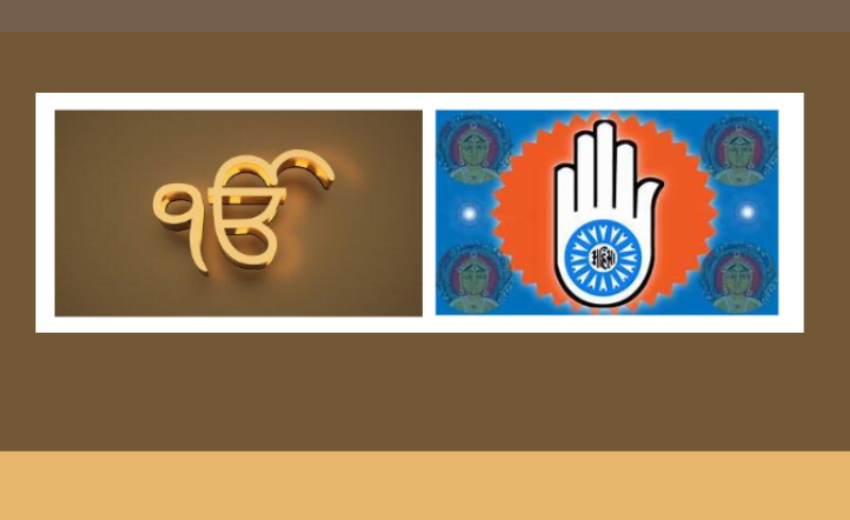Abstract
India is known for its religious diversity, and among its many faiths, Sikh and Jain Dharmic traditions stand out for their ethical and spiritual significance. Despite their distinct theological doctrines, both traditions share key values, including compassion, non-violence, truth, and self-discipline. This article explores the ethical and spiritual connections between Sikhi and Jain traditions, focusing on their mutual emphasis on Ahimsa (non-violence), truth (Satya), and the importance of self-discipline and service. Through their common principles, both religions promote social equality, inclusivity, and the welfare of all living beings. By examining these shared values, the article highlights how Sikh and Jain dharmic traditions contribute to the broader message of harmony in diversity and interfaith coexistence. Ultimately, these traditions offer valuable insights into building a peaceful, compassionate, and just society that transcends religious boundaries and fosters global unity.
Introduction
India’s rich religious mosaic is home to many traditions, each contributing its unique spiritual wisdom. Among these, Sikh and Jain dharmic traditions, though distinct in their theological foundations and practices, both emphasize ethical living, compassion, and self-discipline. Despite the differences in their teachings, both religions highlight values such as non-violence (Ahimsa), truth (Satya), and service to humanity. Sikhism, founded by Guru Nanak in the 15th century, advocates for equality, justice, and devotion to God, with a focus on living an honest, compassionate life [1-6]. Jainism, an ancient faith rooted in the teachings of Lord Mahavira, promotes a strict code of non-violence and asceticism, with a goal of achieving spiritual liberation through purity of thought, speech, and action [7-12].
Both traditions also stress the importance of social equality and communal welfare, promoting practices like selfless service and humility. The concept of Seva in Sikhism [6] and Anukampa in Jainism [7] both encourage individuals to serve others without expectation of reward. Furthermore, the notion of truth and righteousness runs deep in both faiths, guiding adherents towards ethical conduct and honest living [12-15]. This article delves into the ethical and spiritual connections between Sikh and Jain traditions, exploring their shared values and practices emphasizing unity in diversity. By highlighting these intersections, we can better appreciate how these traditions foster interfaith dialogue and mutual respect in an increasingly polarized world.
Research Methodology
This article employs a qualitative comparative research methodology to explore the ethical and spiritual connections between Sikh and Jain Dharmic traditions. The research draws on primary and secondary sources, including sacred texts, scholarly articles, and historical accounts, to identify shared values and principles. The primary texts include the Guru Granth Sahib (Sikh holy scripture) [4-5] and Jain scriptures such as the Agamas [16] and Tattvartha Sutra [17]. These texts provide foundational insights into the core ethical teachings of both traditions, particularly regarding Ahimsa (non-violence), Satya (truth), and self-discipline.
Secondary sources, including academic papers, books, and articles by experts in Sikh and Jain traditions, offer comparative analyses of the two religions and their spiritual practices. Furthermore, the study analyzes contemporary practices and interpretations of these teachings within Sikh and Jain communities and their relevance to modern ethical dilemmas.
The methodology emphasizes a thematic analysis approach, categorizing common ethical and spiritual values to understand the broader implications of Sikh and Jain teachings. This comparison contributes to the discussion of interfaith dialogue and coexistence, offering a nuanced understanding of how these traditions promote social harmony.
Ethical Foundations: Ahimsa and Compassion
One of the most significant ethical connections between the Sikh and Jain Dharmic traditions is their emphasis on compassion and nonviolence (Ahimsa) [12-15]. Jain Dharma considers Ahimsa the highest principle, advocating strict nonviolence not only towards humans but also towards all living beings. Jains follow a vegetarian lifestyle, avoid harming even the smallest creatures, and practice careful speech and actions to minimize harm.
While the Sikh religion is not as stringent in its approach to Ahimsa as the Jain religion, it also upholds the importance of compassion and respect for all life. Guru Nanak, the founder of the Sikh religion, preached against cruelty and injustice, emphasizing the need for kindness and service to humanity [3]. The Sikh concept of "Seva" (selfless service) aligns with the Jain principle of "Anukampa" (compassion), both encouraging individuals to work for the welfare of others.
Truth and Righteousness
Sikh and Jain traditions both strongly emphasize truth (Satya) and righteous conduct [15, 18]. Jainism sees truth as one of the five main vows (Satya Vrata), requiring its followers to be honest and avoid falsehood in any form. Jains believes that truth should be spoken with care so as not to harm others [7, 9].
Similarly, Sikh religious tradition upholds truth as a central virtue, encapsulated in Guru Nanak’s teaching: "Satnam" (God’s name is truth). Sikhs are encouraged to live truthfully, stand against injustice, and engage in honest labour (Kirat Karni). Guru Gobind Singh’s philosophy of "Deg Tegh Fateh" (Victory of the Sword and the Cauldron) symbolizes the importance of sustaining truth through both righteousness and charity [20].
Spiritual Practice and Self-Discipline
Both traditions emphasize self-discipline and inner purification as essential spiritual practices. Jainism’s concept of asceticism (Tapas) involves rigorous self-control, meditation, and penance to purify the soul and achieve liberation (Moksha). Monastic Jains observe extreme discipline, renouncing material attachments and dedicating their lives to spiritual growth [9-10].
While the Sikh faith does not advocate extreme asceticism, it promotes discipline through regular prayer, meditation on God’s name (Naam Simran), and adherence to moral principles. The Sikh code of conduct (Rehat Maryada) [21] emphasizes ethical living, community service, and devotion to God. The practice of Amrit (baptism) in the Sikh religion bears similarities to the vows taken by Jain monks, signifying a commitment to a disciplined spiritual life.
Social Equality and Service
A significant commonality between Sikh and Jain religious traditions is their emphasis on social equality and selfless service. Sikhi tradition strongly advocates for equality, rejecting caste distinctions and promoting the concept of Langar (community kitchen), where food is served to all, regardless of social status. This practice embodies the principles of humility and inclusiveness [22-24].
Jainism, while historically associated with certain social hierarchies, also emphasizes equality at the spiritual level. The principle of Anekantavada (the multiplicity of viewpoints) teaches respect for diverse perspectives, fostering an environment of tolerance and peaceful coexistence. Jains are also known for their philanthropic contributions, supporting hospitals, animal shelters, and educational institutions, reflecting their commitment to service [12-14].
Interfaith Harmony and Coexistence
Both traditions provide valuable lessons in interfaith harmony and coexistence. Jain Dharma, with its doctrine of Anekantavada, encourages dialogue and understanding between different beliefs, recognizing that no single viewpoint holds absolute truth [7-10]. This principle aligns with Sikhism’s emphasis on universal brotherhood and acceptance of all religions [25-27. Guru Granth Sahib, the Sikh holy scripture, includes hymns from saints of various religious backgrounds, demonstrating an inclusive approach to spirituality [4-5].
Conclusion
Despite their theological distinctions, Sikh and Jain Dharmic traditions share profound ethical and spiritual connections that reflect a commitment to values essential for fostering harmony and peace. Both traditions emphasize compassion and non-violence as central ethical principles, though they manifest these values differently. Jain tradition’s strict adherence to Ahimsa and its emphasis on asceticism offers a model of purity and restraint. At the same time, Sikhism’s approach is rooted in selfless service (Seva) and social justice, focusing on inclusivity and humility. Both religions, however, stress the importance of compassion toward all living beings, whether through the vegetarian practices of Jains or the active service to humanity promoted by Sikhs.
The shared values of truth, self-discipline, and social equality further reinforce the ethical framework of these traditions. Jain Dharma’s focus on nonviolence in thought, speech, and action complements Sikhism’s emphasis on truth and righteousness, guiding followers toward ethical living. Both traditions also promote the idea of inclusivity—Sikhism’s rejection of caste discrimination and Jainism’s commitment to peaceful coexistence through Anekantavada. The acceptance of multiple perspectives encourages tolerance and understanding among different communities.
By recognizing the common ethical and spiritual principles that bind Sikh and Jain Dharmic traditions, we can deepen our understanding of these faiths and work towards more excellent interfaith dialogue and cooperation. These traditions not only provide ethical guidance but also inspire individuals to contribute to the welfare of all, promoting a world where diversity is celebrated, and unity is embraced. Ultimately, the teachings of Sikh and Jain religious traditions offer a timeless message of righteousness, compassion, peace and shared humanity.
References
- Singh, Daljeet, Singh, Kharak. (Eds.). (1997). Sikhism: Its Philosophy and History.Institute of Sikh Studies. Chandigarh.
- Singh Daljeet. (1994). Essentials of Sikhism. Singh Brothers. Amritsar. India.
- Singh, Deviinder Pal. (2014, July-Aug.) Relevance of Sri Guru Granth Sahib in 21st Century, The Sikh Bulletin, USA. 17 (7& 8). pp.18-22
- Sri Guru Granth Sahib (SGGS), 1983 (Reprint), S.G.P.C., Amritsar, p 1-1430.
- Singh, S. Guru Granth darpan. https://www.gurugranthdarpan.net/
- Singh, D. P. (2023). Spirituality - A Gurbani Perspective. The Sikh Review, Kolkata, WB, India 71 (6): 10-14.
- Jain, P. (2019). An Introduction to Jain Philosophy. New Delhi, India: D. K. Printworld (P) Ltd.
- Long, J. D., Miller, C. P., & Reading, M. (Eds.). (2019). Beacons of Dharma: Spiritual Exemplars for the Modern Age. Lexington Books, USA.
- Wiley, K. L. (2009). The A to Z of Jainism (Vol. 38). Scarecrow Press.
- Jain, A. K. (2009). Faith & Philosophy of Jainism (Vol. 6). Gyan Publishing House.
- Bilimoria, P., Bohanec, C., & Sherma, R. D. (Eds.). (2023). Contemplative Studies & Jainism. India: Routledge India.
- Ved P. Nanda (Ed.), (2016). Compassion in the 4 Dharmic Traditions: Exploring Empathy in Religions. Prabhat Prakashan. New Delhi. ISBN: 9351867366, 9789351867364
- Agnihotri, V., & Agnihotri, V. (2017). Hinduism, Jainism, and Sikhism. Better health through spiritual practices, 29-42.
- Nigosian, S.A. (1994). Jainism and Sikhism. In: World Faiths. Palgrave Macmillan, London. https://doi.org/10.1007/978-1-349-13502-8_7
- Singh, Devinder Pal (2023). Truthful Living: A Perspective from Sikhism. Horizon J. Hum. Soc. Sci. Res. 5 (2), 132–139. https://doi. org/10.37534/bp.jhssr.2023.v5.n2.id1212.p132
- Shah, P. K (2022, August 26). Agam literature. Jain Study Center of North Carolina. https://jainworld.com/literature/jain-agams/jain-agam-literature/agam-li...
- Jain, V. K. (2018). Ācārya Umāsvāmī’s Tattvārthasūtra – With Explanation in English from Ācārya Pūjyapāda’s Sarvārthasiddhi. Dehradun, India: Vikalp Printers.
- Singh, D. P. (2025). A Path to Truthful Living. Singh Brothers, Amritsar, India. (In Press).
- Siṅgh, Ḍ. P. (2018). Science and Sikhism: Conflict or Coherence (1st ed.). Singh Brothers, Amritsar, India.
- Dahiya, A.S. (2015, March 18). Founder of the Khalsa: The Life and Times of Guru Gobind Singh. Hay House India. ISBN-13 978-9384544294
- S.G.P.C. Amritsar. (1994). The Sikh Reht Maryada (The Code of Conduct and Conventions). Dharam Parchar Committee, S.G.P.C., Amritsar.
- Singh, D. P. (2019, Dec.). Universal Relevance of Guru Nanak’s Teachings, (Part -II), The Sikh Review. Kolkata, India. 67 (12).19-30.
- Singh, D. P. (2019, Nov.). Universal Relevance of Guru Nanak’s Teachings, (Part-I), The Sikh Review. Kolkata. India. 67(11). 15-21.
- Singh, D.P. (2022, June). Role and Relevance of Gurudwaras in Global Context - An Interview. The Sikh Review. Kolkata. India. 70 (6). 49-59.
- Singh, D. P. (2020, Oct.-Dec.). Interfaith Dialogue: A Perspective from Sikhism, Abstracts of Sikh Studies, Chandigarh. India. XXII (4).
- Singh, D. P. (2019). The Doctrine of World Peace and Universal Fellowship in the Hymns of Guru Nanak. Punjab Dey Rang. Lahore. PK. 13 (4). 5-11.
- Singh, D. P. (2020). Nanakian Perspective on World Peace and Brotherhood of Humankind. In Philosophy of Guru Nanak Searching Peace, Harmony & Happiness, Sucha Singh Gill (ed.), Centre for Research in Rural and Industrial Development. Chandigarh, India. 177-192.
*****





